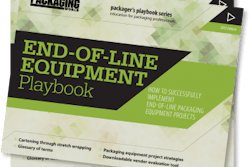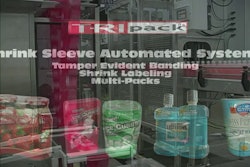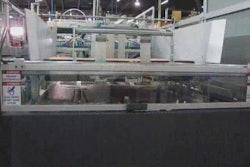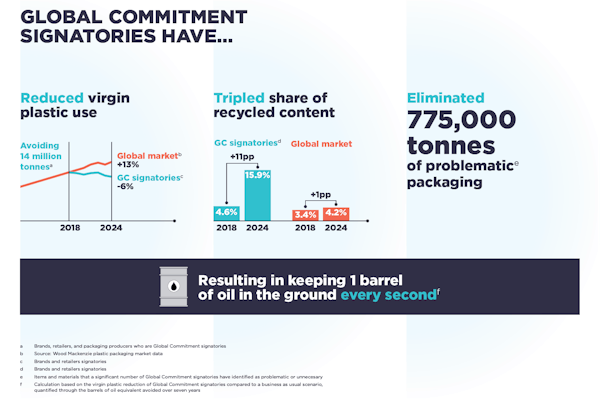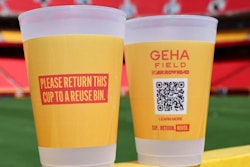1. Retail-ready case packing. Originally driven by club stores, secondary packaging that can be deployed right on the retail floor with attractive graphics and tear-away sections or panels has probably been one of the biggest developments in secondary packaging in recent years. The latest challenge is to be able to produce smaller-count cases at higher speeds to maintain processing speeds. Also, using shelf packages with visible product (such as windows or exposed carton corners) requires automated machinery that minimizes surge pressure during packaging. The kind of vacuum used to pick a case up really matters now. Machines cannot mark, mar, or damage the cases in any way, because they’re being used as displays now.
2. Lightweighting. Partly for sustainability reasons but also for cost savings, packagers are seeking to use thinner bags, thinner corrugated board, and thinner cartons. Machines have been redesigned accordingly, handling product a lot more gingerly than they used to, but still at high speeds. End-of-line packaging machines used to be typically fixed-automation machines. But now, to handle the proliferation of container shapes, sizes, and lighter weights, what’s required is more low-pressure conveyance, more customization, servos, and more robotics. Robotics can be more efficient at handling lighter weight packaging because of the amount of pressure and stress put on containers can be more tightly controlled. Pick-and- place robots might be less likely to cause package damage versus more conventional fixed- automation and drop-pack systems.
3. Increased recycled content cases. Previously, case packers handled virgin corrugated board all the time. As packers are now seeing a lot more recycled content, it means that machines have had to be more forgiving and provide for more tolerance of variation in the quality of the cases and trays. Equipment really has to be less sensitive and more tolerant, as variations are appearing on a more frequent basis. Recycled corrugated board also shows more variation in how it reacts to the environment than virgin board. Humid or cold environments add to the need to build more tolerant machines. Vendors see this as an opportunity to differentiate, showing that they can handle these variations. This leads to design changes, different engineering, or reengineering: more use of high-strength, lightweight materials in machines now, such as carbon fiber for end-of-arm tools, lighter-weight metals and other advances in control and precision.
4. Machines that accommodate packaging variety. Marketing requirements are pushing the use of so many different packages that suppliers must be able to deliver case packers that can, with just a few change parts, swiftly change over and accommodate the larger variety of case sizes and formats. The challenges are to convey, accumulate, carton, case and/or wrap these packages at high speeds, while keeping them well protected, and to be able to rapidly changeover to different package types, pack configurations, or various “rainbow“ pack combinations (for example, on-the-spot changeover of flavor selections in a multi-pack of beverage bottles). The increasing use of servo technology is permitting this flexibility. Quicker changeovers are driven by the desire to offer greater customer choice to address occasion-based marketing— the right product in the right package at the right time and place. Occasion-based marketing depends on the ability to produce multiple packaging formats for venues as diverse as hotel chains, restaurants, club stores, and convenience stores. Machinery users want to be able to run all these diverse formats on the same equipment.
5. Adhesive advances. Manufacturers of adhesive and adhesive applicator equipment have not stood idly by either, introducing innovations such as non-heated adhesive application systems that deliver a foamed adhesive with rapid set properties. Advantages including up to 50% less adhesive use than conventional systems, room temperature pumping and flowing of adhesive that eliminates the need for heated tanks and hoses, increasing safety. Also, newer hot melt fast set adhesives are debuting, eliminating the need for excessive heating and hot system engineering, resulting in savings opportunities on wear parts and maintenance because of the reduction in heated components.
6. More integration. Packagers are pushing for more integration in their lines; instead of buying discrete pieces of machinery and cobbling them together, they really are requiring that OEMs integrate complete end of line solutions that achieve the desired output for the entire line. Packagers want machines that can be able to communicate with each other; they’re looking at the lines holistically. They want the HMIs to have a similar look and feel, more standardization of components, and they’re specifying standardization of pumps and controls, and are beginning to adopt PackML to streamline integration between machines. A common platform also makes it easier for packagers to train their operators. In short, what’s driving case packing design is packagers’ need to make the equipment easier to use, more accessible for less experienced operators, simpler, faster changeover, and greater flexibility because packaging styles change at an unprecedented rate.
1. Retail-ready case packing. 2. Lightweighting. 3. Increased recycled content cases. 4. Machines that accommodate packaging variety. 5. Adhesive advances. 6. More integration. 
